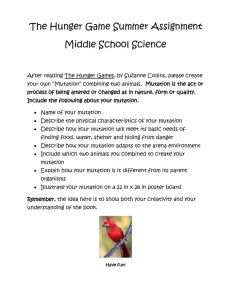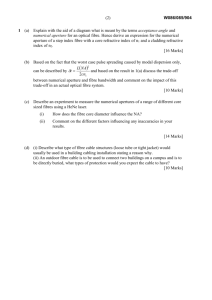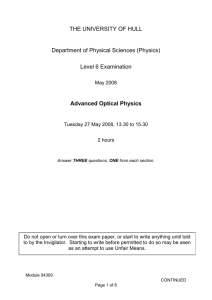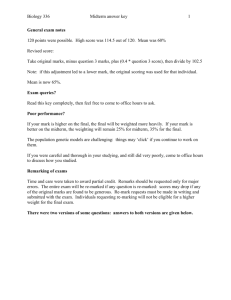Part I ( 40) Answer all questions
advertisement
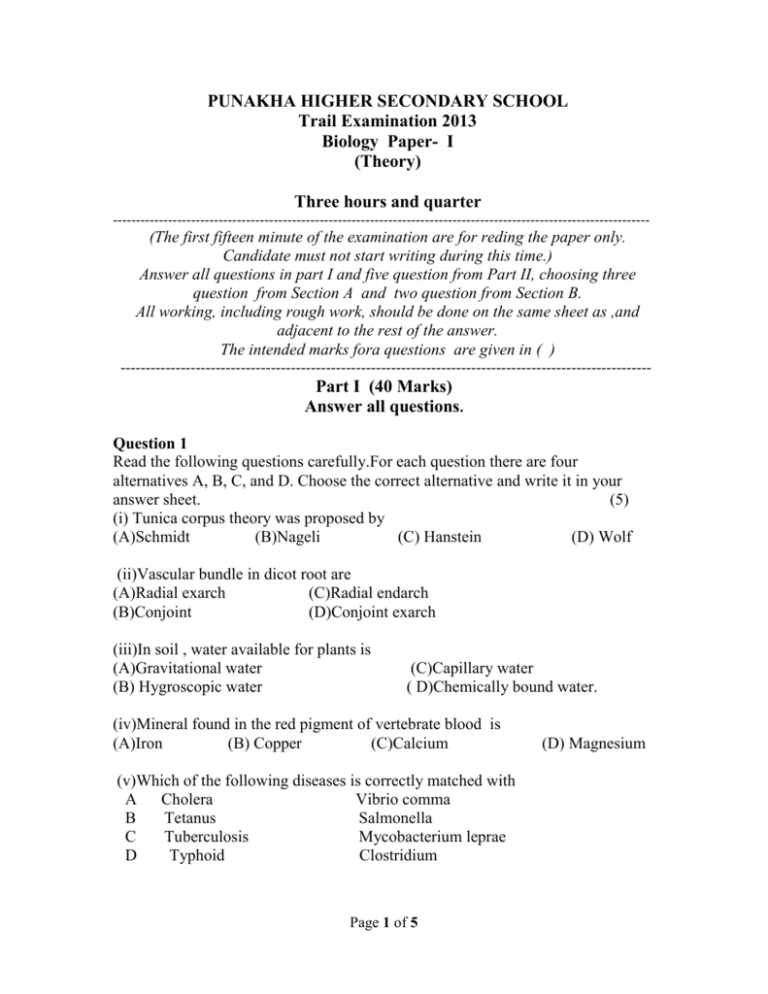
PUNAKHA HIGHER SECONDARY SCHOOL Trail Examination 2013 Biology Paper- I (Theory) Three hours and quarter --------------------------------------------------------------------------------------------------------------------- (The first fifteen minute of the examination are for reding the paper only. Candidate must not start writing during this time.) Answer all questions in part I and five question from Part II, choosing three question from Section A and two question from Section B. All working, including rough work, should be done on the same sheet as ,and adjacent to the rest of the answer. The intended marks fora questions are given in ( ) ---------------------------------------------------------------------------------------------------------- Part I (40 Marks) Answer all questions. Question 1 Read the following questions carefully.For each question there are four alternatives A, B, C, and D. Choose the correct alternative and write it in your answer sheet. (5) (i) Tunica corpus theory was proposed by (A)Schmidt (B)Nageli (C) Hanstein (D) Wolf (ii)Vascular bundle in dicot root are (A)Radial exarch (C)Radial endarch (B)Conjoint (D)Conjoint exarch (iii)In soil , water available for plants is (A)Gravitational water (B) Hygroscopic water (C)Capillary water ( D)Chemically bound water. (iv)Mineral found in the red pigment of vertebrate blood is (A)Iron (B) Copper (C)Calcium (v)Which of the following diseases is correctly matched with A Cholera Vibrio comma B Tetanus Salmonella C Tuberculosis Mycobacterium leprae D Typhoid Clostridium Page 1 of 5 (D) Magnesium (b)Fill in the blanks and write the correct answer the answer sheet.(5) (i)In C3 plants CO2 Acceptor is................ While in C4 plants CO2 acceptor is ............... (ii)The reaction centre of PSI is .................... While reaction centre of PSII is ............... (iii) The first product of C-3 plant is .......... While first stable product ot C4 plants is .......... (iv) Blood pressure is determind as..................and ...................pressure. ( v) The changes in the.....................genes in a chromosomes occure in ...............mutation. (C)Match each item under column A with that which is most appropriate in column B.You must rewrite the correct matching pairs. (5) Column A (i) Corpus luteum (ii)Corpus callosum (iii) Phytochrome (iv) Endosperm (v) Fovea centralis (vi) Master gland (vii)Insulin (vii) Goitre (ix) Ptylin (x)Haemopoisis ColumnB a- Production of blood corpuscles b- Starch c- Iodine d- Connect two cerebral hemisphere e- Progesteron f- Food g-Yellow spot h- Diabetes mellitus i- Photoreceptor molecule j- Pituitary (d)Write one important function of each of the following. (i) Magnesium in plants (iv) SA node (ii) Micropyle (v) Neutrophils (iii)ADH ( Antidiuretic hormone) (5) (e) Answer the following (10) (i)What is the full form of IAA and IBA? (ii) What are vestigeal organ? (iii)Why do the plants bend towards the source of light? (iv)What is meant by double circulation? (v)The membrane of resting nerve fibre is said to be in a polarized sate.What is meant by this statement? Page 2 of 5 (f)Define the following terms. (i) All or none law (ii) Cleistogamy (iii) Chelatores (5) (iv) Deplasmolysis (v) Speciation (g) Mention one significant difference between each of the following (i) Benign tumour and Malignant tumours (ii)Down’s syndrome and Turner’s syndrome (iii)Tropic movements and Nastic Movements (iv)Somatic mutation and Heritable mutation (v)Depressants and Stimulants (5) Part II Section A (30 marks) Answer any three questions. Question 2 (a)Explain various types of vascular bundles. (4) (b) What do you understand by the term ureotelism? How does it differ from uricotelism ? (3) (c)Explain the term double fertilization and Triple fusion. (3) Question 3 (a)With the help of sketch, explain non cyclic photophosphorylation. (4) (b)What are the function of growth hormone Describe diseases caused by hyposecretion and hypersecretion of growth hormone? (3) (c)What is the role of Phytochrome in germination of seed ? (3) Question 4 (a) Describe the mechanism of muscles contraction and relaxation with the help of sliding filament theory . (4) (b)Diagramatically show the components of reflex arc (use arrows to indicate flow of impluse) (3) (c)What is a synapse? How is the nerve impluse transmitted across a synapse ? (3) Question 5 (a) Define following terms (4) (i) Vernilization (iii) Abscission (ii)Viviparous germination (iv)Imbibition Page 3 of 5 (b) Draw labelled diagram of T. S. of artery and T.S. of vein. (c)Give summary of events during clotting of blood. (3) (3) Question 6 (a) Explain the working and uses of electrocardiograph. (4) (b) (i)Write four points of difference between Red muscles fibre and White muscles fibre. (2) (ii)Define stem cell (1) (c)Write short note on tissue culture . (3) Section B (30 marks) Answer any two questions Question 7 (a) (i) Archeopteryx is considered as a connecting link between reptiles and birds. Justify statement by giving two charecters of each. (3) (ii)Differentiate between homologous organ and analogous organ with example. (3) (b) (i)Explain the existance of long necked Giraffe on the basis of Lamark’s theory and Darwins theory. (3) (ii)Explain atavism with examples. What does it support? (3) (c) How is sickle cell carrier has an advantage over the rest of the human population in a malaria ridden area? (3) Question 8 (a) (i) Describe briefly Stanley Miller and Urey’s experiment. (3) (ii)Give three features in which human being are considered more advance than apes. (3) (b) (i)What is mutation? Differentiate between transition and transversion. (3) (ii)Define biogeography. How does Darwin Finches provide biogeographical evidence in favour of evolution? (3) (c)What are coacervates ? (3) Page 4 of 5 Question 9 (a) (i)What are biofertilizers.? Why biofertilizers are preferred over chemical fertilizers ? (3) (ii) Give three point of difference between active immunity and passive immunity. (3) (b)(i)What are interferons.? Which diseases can be treated by interferons (3) (ii)Write short note on hazards in the use of pesticides. (3) (c)Describe role of biology in amelioration of human problems. (3) Question 10 (a) (i) What is hybridization? Explain its types. (ii) Differentiate between callus culture and suspension culture. (b) Define following terms (i) Germplasm (ii) Gene pool (iii)Cryopreservation (c) (i)What is amniocentasis ? (ii) Write three point of difference between T cell and B cell . “ Intelligent hardwork is directly proportional to result“ ALL THE BEST Page 5 of 5 (3) (3) (3) (3) (3)








